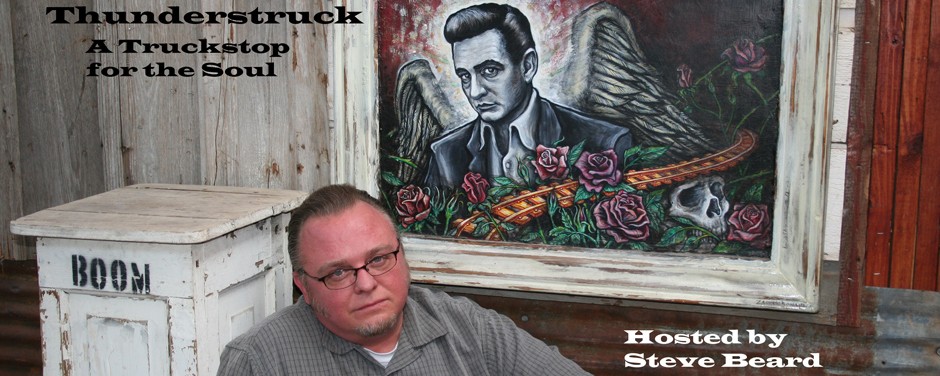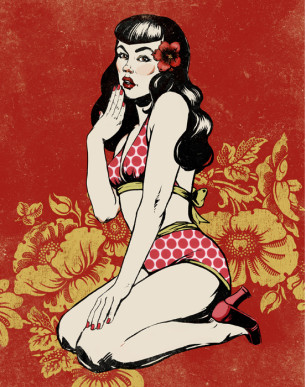By Steve Beard
Ah, those jet-black Bettie Page bangs. Fifty years after they were immortalized on a pin-up icon, you still see them on the pale hipster chicks with the cat-eyed glasses. That is just one of the lasting manifestations of Bettie Page’s industrious and enigmatic seven-year modeling career. She was a splash of rockabilly, a dash of Goth, and an extra helping of sass. The Los Angeles Times described her as a “taboo breaker who ushered in the sexual revolution of the 1960s.”
Page died on December 11, 2008, at the age of 85. She suffered a heart attack the previous week and had been placed on life support, never regaining consciousness.
In some ways, Bettie Page is more popular today than she was in the Eisenhower-era. You can purchase her image on playing cards, t-shirts, lunch boxes, beach towels, lighters, key chains, and fridge magnets. There is even a Bettie Page action figure. Her web site has received 626 million hits since August 9, 2000.
Her legendary status was captured on the silver screen a few years ago in the film The Notorious Bettie Page. It attempts to chronicle the unlikely life of a religious Southern girl who, arriving in New York City in 1950, becomes a world-famous pin-up.
Her nude or scantily-clad image appeared in magazines such as Escapade, Wink, Titter, Eyeful, and Playboy. She was a hit with the underground fetish and bondage enthusiasts when she posed with whips, was tied to chairs and trees, and wrestled with other underwear-clad women in scenes that looked like a 1950s sorority initiation gone awry.
It didn’t matter if she was posing with a leopard skin bikini or a tight leather corset and thigh-high boots; she had a bright and playful smirk of innocence as though she were at a costume party without the spiked punch.
According to Bettieophiles, she had more magazine appearances than Marilyn Monroe and Cindy Crawford combined. In 1957, however, she suddenly disappeared and never again appeared for any photo shoot.
In whatever way the vanishing act may have added to her mystique, the effect was unintentional. Bettie simply didn’t want to model anymore. There were too many stalkers and weirdoes. In 1955, Page even found herself the target of a congressional investigation on the matter of pornography and juvenile delinquency led by moral crusader Sen. Estes Kefauver (D-TN).
World-famous Bettie never had a manager, stylist, publicist, or lawyer. She never dated anyone famous and even declined the offer to meet with fans such as Howard Hughes. The one characteristic that marked Bettie Page—aside from her figure—was her independent streak.
For nearly forty years, no one knew what happened to her. She disappeared from public view. Journalists Karen Essex and James L. Swanson were the first to track her down and publish her authorized biography, Bettie Page: The Life of a Pin-Up Legend in 1996. What happened after her modeling career only makes her more fascinating.
There is a poignant scene in The Notorious Bettie Page when she is asked by a photographer, “What do you think Jesus would say about what you are doing now?” Having been raised in church, Bettie Page (played by Gretchen Mol) responds, “I hope that if he is unhappy with what I am doing he’ll let me know somehow.”
Whether or not Jesus got terribly specific about her career choices, she certainly experienced an epiphany. Page was walking on the beach in Key West on New Years Eve, 1959, when she noticed a little white church with a neon cross and heard singing inside.
In a very rare interview with The Los Angeles Times not long ago, Page remembered, “The Lord took me by the hand and we stepped inside. I was crying in the back row about my sins. I turned my life over to the Lord.”
Over the following three years, Page attended the Bible Institute of Los Angeles (Biola), the Moody Bible Institute in Chicago, and the Multnomah School of the Bible in Portland, Oregon. For several summers, she attended the Winona Lake Bible Conference in Indiana founded by the flamboyant evangelist Billy Sunday.
While she was living in Chicago, she was a counselor at a massive Billy Graham Crusade. “I’m more proud of my work with the crusade than of anything else I’ve ever done,” she told the Times. “I get emotional just thinking about it. If ever there was a man of God, it’s Billy Graham.”
She wanted to be a missionary and applied to various mission boards but was rejected—not because she had been a fetish pin-up, but because she had been divorced. She spent the rest of her life living quietly and happily in obscurity, working as a secretary, a teacher, and then eventually living modestly off of Social Security. She had no idea that the world was intrigued by her whereabouts.
She never changed her name, or her famous hairstyle. When she was asked if she was Bettie Page, she would playfully reply, “Who’s that?” “I was never trying to keep away from people, I was just through with modeling and went on to other things,” she told Essex and Swanson. “I went right on living my life in the open all the time.”
Her raven hair turned gray. Bettie Page shunned the cameras, choosing instead to be remembered as the bombshell of her younger years. She harbored few regrets, with the exception of some of the bondage photos. “I had lost my ambition and desire to succeed and better myself; I was adrift,” she soberly confessed to the Times at age 83. “But I could make more money in a few hours modeling than I could earn in a week as a secretary.”
As for the rest of her portfolio, she remained unbowed. “From the first time I posed nude, I wasn’t embarrassed or anything,” she says. “I never thought it was terrible to be in the nude. After all, God created man and woman totally nude and put them in a garden. If they hadn’t turned against Him and disobeyed Him, they might have remained in the nude all their lives.”
In the current configuration of the cultural standoff in America, neither liberals nor conservatives are quite sure what to do with Bettie Page. She was neither a libertine nor a prude. She opposed promiscuity and favored nudity. She considered Billy Graham a hero and Hugh Hefner a friend. She followed Jesus and loved to skinny dip. Bettie was simply Bettie.
“I was not trying to be shocking, or to be a pioneer,” she once wrote. “I wasn’t trying to change society, or to be ahead of my time. I didn’t think of myself as liberated, and I don’t believe that I did anything important. I was just myself. I didn’t know any other way to be, or any other way to live.”
Steve Beard is the creator of www.thunderstruck.org – a website devoted to faith and pop culture.


Pingback: The pin-up and the preacher | Thunderstruck Media Syndicate